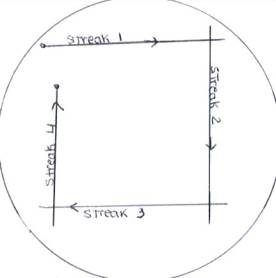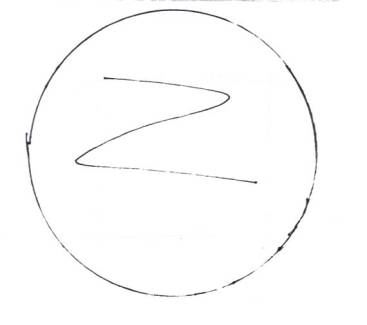 Make
sure that when you are making the streaks they intersect at each corner as
illustrated by this diagram.
Make
sure that when you are making the streaks they intersect at each corner as
illustrated by this diagram.Carlos Franco Return to Biology Menu
Summer 2001
Living Environment
Isolating bacteria from a mix culture
Goals:
1. Students will isolate three species of bacteria using the plate streak method
2. Students will implement sterile microbiology techniques.
3. Students will produce pure cultures of each microorganism at the end of this exercise
Duration of activity: (3) days
Day 1: Streaking plates with mix culture (30 min)
Day 2: Inoculating nutrient broth tubes with colonies in streaked plates (20 min)
Day 3: Observe plates and record/ discuss results (30 min)
Science Standards:
Standard 5: Students will apply technological knowledge and skills to design, construct, use and evaluate products and systems to satisfy human and environmental needs
Standard 2: Students will access, generate, process, and transfer information using appropriate technologies.
Materials:
|
Specimens Culture of Escherichia coli |
Apparatus(1)Inoculating loop per group |
|
Culture of Serratia marcescens |
(8) Nutrient agar plates per group |
|
Culture of Micrococus lutea |
(6) 3ml/nutrient broth tubes |
|
|
(1) Bunsen burner per group |
|
|
(1)Incubator @37 °C (optional) (1) Pack of colored pencils |
Preparation:
Before commencing this activity prepare the following:
1.Inoculate 5ml of nutrient broth with Escherichia coli, Serratia marcescens, and Micrococus lutea. Place in incubator @ 37°C for 24 hours or 48 hours at room temperature;
2. Prepare nutrient agar plates (18ml/plate) and nutrient broth (3ml/tube) 24 hours before activity . Store plates and tubes in a refrigerator until ready to use.
Standards addressed:
1. Interpretation and analysis of data
2.
Hands on activity
3. Cooperative learning
Motivation:
Q. Have student brainstorm why is it important to separate the components in a mixture. What can we learn by separating the components of a mixture?
Have students write out the methods they would use to separate the components of a mixture of sand, iron filing, and oil.
Possible keywords in responses: density, magnetism, filtration; funnel, etc.
Procedure:
Day 1
 Make
sure that when you are making the streaks they intersect at each corner as
illustrated by this diagram.
Make
sure that when you are making the streaks they intersect at each corner as
illustrated by this diagram.
While streaking make sure you minimize talking to avoid contamination.
As soon as you finish cover the plate immediately.
Write descriptive paragraph for each specie of bacteria in the mix: Escherichia
coli, Serratia marcescens, and Micrococus
lutea. Describe their physical
characteristics as well as the conditions they need to grow best.
Hint: Use a search engine
on the Internet, i.e.. Infoseek, Lycos, etc. and search for each specie at time.
Procedure: Day 2

Describe the streak- cross method as a method of separating bacteria from
a mix culture. How does streak
-cross method work?
Hint: Internet search engines
Procedure:
Day 3